This Sourdough Asiago Herb Fougasse, crafted with an overnight levain, incorporates a blend of all-purpose, spelt, and rye flours, and is generously infused with Asiago cheese and rosemary. Before baking, the flatbread is brushed with olive oil, and sprinkled with extra rosemary and Parmesan cheese, creating a perfect harmony of flavors and textures.
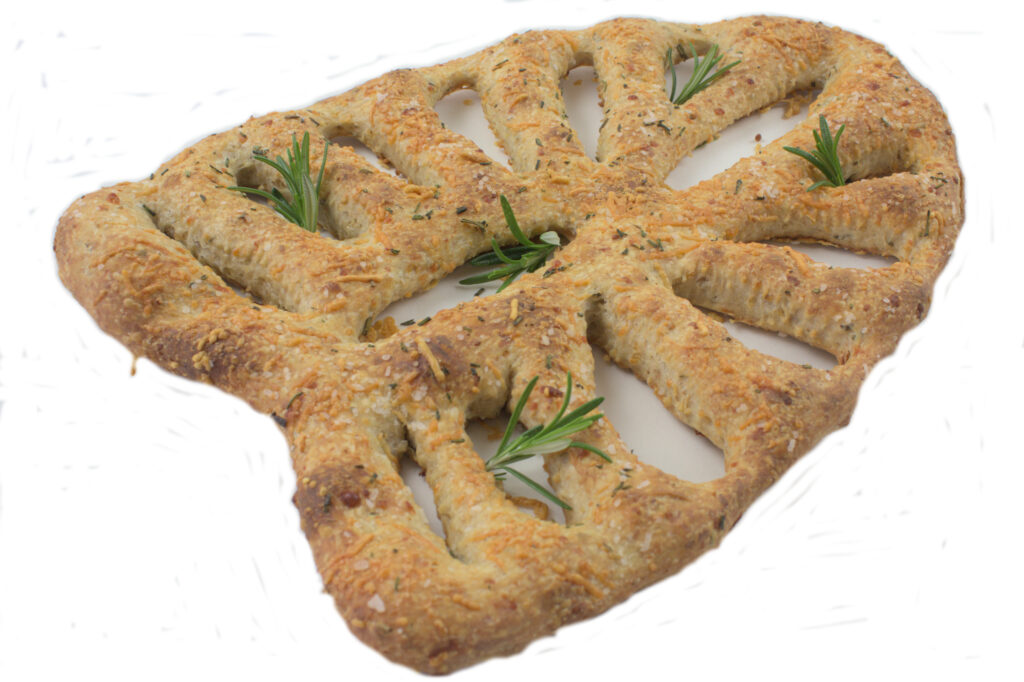
What is Fougasse?
Fougasse is a traditional French bread, often associated with the region of Provence. This French flatbread is known for its distinctive shape, which resembles an ear of wheat or a leaf, with multiple slits cut into the dough before baking. These slits not only create a visually appealing pattern but also allow the bread to bake quickly and evenly, resulting in a crisp crust and a soft, airy interior.
Fougasse is typically flavored with ingredients like olives, herbs (such as rosemary or thyme), garlic, and sometimes cheese or anchovies, making it a flavorful and aromatic accompaniment to various meals. It’s particularly popular as an appetizer or snack, often enjoyed with a glass of wine.

Making this Sourdough Asiago Herb Fougasse is a fun experiment
Fougasse is the bake of the month for the Bread Baking Babes. Elle Baker, of Feeding My Enthusiasms, chose this delightful bread and provided us with a variety of options for making it.
The basics of the fougasse challenge are to make a leaf-shaped, slashed bread, preferably with the recipe(s) provided, but you decide the shape, flavorings, and whether you will use sourdough or not. Elle Baker
I adapted her method to make two fougasse instead of four, utilized an overnight levain, incorporated spelt and rye, and filled the dough with cheese and rosemary. I also revised the mixing method to include an autolyse. I had a lot of fun with this one. I made it several times. Each time I made it, I increased the amount of cheese and rosemary.
I brought this Fougasse to enjoy at a Holiday gathering. I was rushing to get there so I didn’t get a great photo.
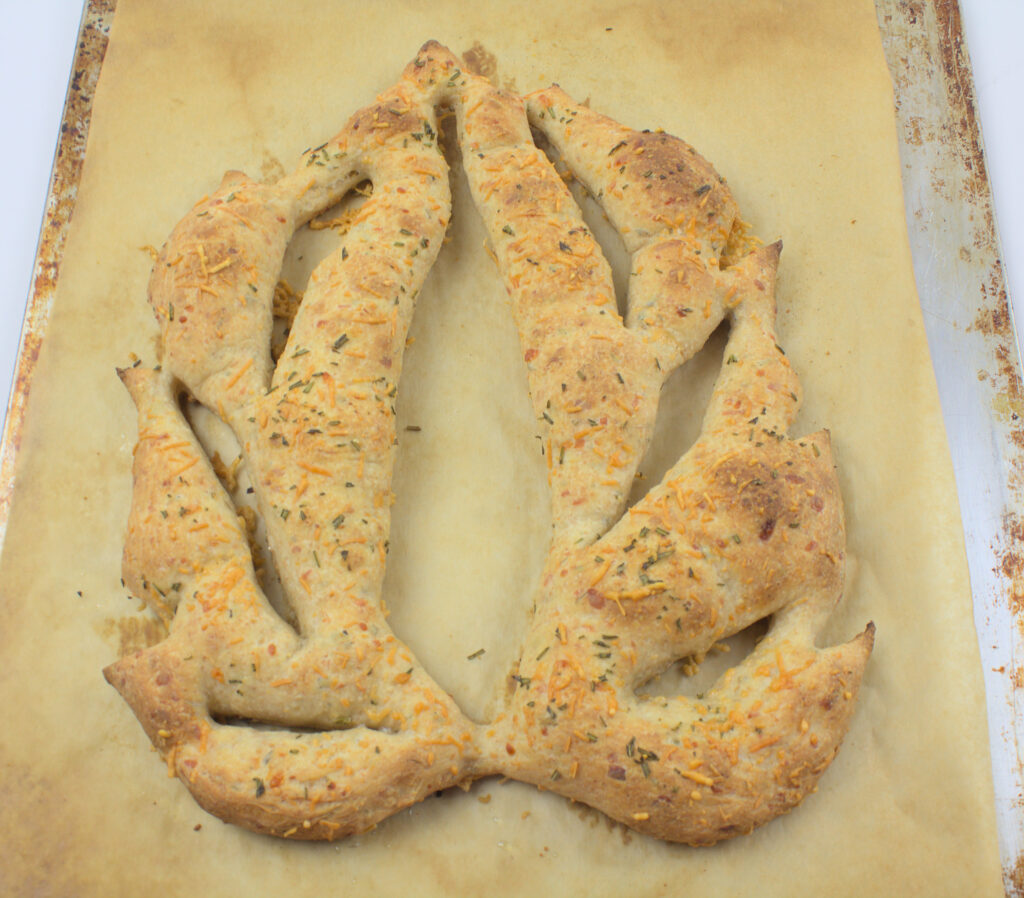
I gave this bread to the hostess of the Holiday gathering.
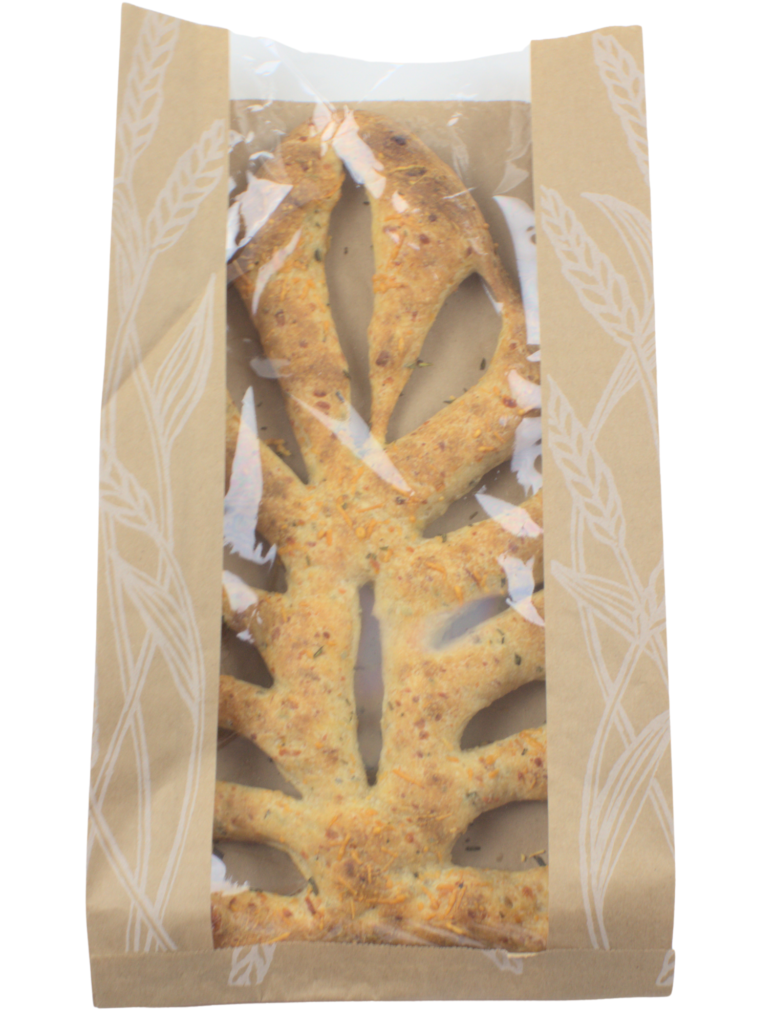
How do you shape Fougasse?
After the bulk ferment, place the dough on a lightly floured counter and fold the dough over itself. Let it rest on the counter for 20 minutes.
Divide the dough into two equal pieces. Note: If you turn the folded dough seam side down, and cut it straight down the middle, lengthwise, it make things really easy.
To make the leaf shape, use wet fingers to press the dough out into a tall triangle (about 10-11-inches on a side and 1/2 – 1-inch high). Place the shaped dough onto a piece of baking parchment (on a baking sheet).
Using a bench scraper or stiff plastic dough scraper or something similar, cut into the dough to make leaf ‘veins’. Use your fingers to gently spread out the dough to open up the cuts.
I experimented making the slits in the fougasse using a metal bench scraper, a straight blade bread lame, and a plastic dough scraper. In my opinion, the dough scraper works the best because you can use different sides of the scraper to control the length of each cut. The lame didn’t really work because I didn’t want to cut through the parchment.
On a whim, I decided to use a pastry wheel on one of the loaves. It worked fairly well. It was easy to control and you could go back and make the slits bigger. I’ll probably try the pastry wheel again.
The method I use to bake this Sourdough Asiago Herb Fougasse
To bake these Fougasse, I use the same method I use to bake baguettes which works really well for my oven. I place an iron skillet on the lowest rack of the oven for steam, a baking steel on the shelf above that and a baking stone on an upper rack (2 racks above the baking steel). If you only have one baking stone, place it on the middle rack with a steam pan on a lower rack.
Preheat the oven to 425 degrees F. and bake the loaf 7-9 minutes on the baking steel (lower rack), then rotate and move the loaf up to the baking stone (upper rack) and bake for an additional 8-10 minutes. Place 1 cup of ice cubes in the iron skillet (steam pan) immediately after placing the loaf in the oven on the lower baking stone. I forgot to use the steam pan for one of the bakes. It was okay, but I prefer the versions baked with steam.
Notes from Elle Baker
You can use sourdough starter or dry yeast, flavor it with rosemary and sea salt…my favorite…but you could use other seasonings like oregano, basil, lemongrass…or use seeds like poppy seeds or sesame seeds to enhance the bread. Consider adding cheese, like a good strong blue cheese, and maybe some walnut pieces. Maybe you would like citrus zest added, or perhaps olives.
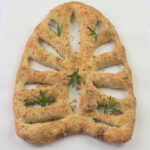
Try this Sourdough Asiago Herb Fougasse with Spelt and Rye
- Yield: 1 flatbread 1x
Description
This Sourdough Asiago Herb Fougasse, crafted with an overnight levain, incorporates a blend of all-purpose, spelt, and rye flours, and is generously infused with Asiago cheese and rosemary. Before baking, the flatbread is brushed with olive oil, and sprinkled with extra rosemary and Parmesan cheese, creating a perfect harmony of flavors and textures.
Ingredients
Levain:
- 100 grams water
- 100 grams all-purpose flour
- 27 grams sourdough starter (from the fridge)
Dough:
- 200–260 grams all-purpose flour, divided
- 75 grams whole grain spelt flour
- 25 grams whole grain rye flour
- 180 grams water
- Levain, all of the above
- 1 tablespoon olive oil
- 6 grams (1 tsp) fine sea salt
- 2 –3 Tbsp. fresh rosemary, finely chopped, divided
- 75 grams Asiago cheese
Toppings:
- Parmesan cheese, or additional Asiago cheese
- Fresh rosemary, finely chopped
- Coarse sea salt, optional
Instructions
Mixing:
- In the bowl of a stand mixer, place 200 grams of all-purpose flour, 75 grams spelt, and 25 grams rye flour and 180 grams of water. Mix on low speed to combine. Cover, and let the flour/water mixture rest (autolyse) for 30 minutes to 1 hour.
- Add the levain, and 1 tablespoon of olive oil. Mix on low speed until thoroughly incorporated. Add in additional all-purpose flour as needed (up to 60 grams), until the dough clears the side of the bowl. You should be able to pull a “window pane” by gently stretching the dough. Let the dough rest 20 minutes.
- Add the salt, and mix on low speed, until the dough is smooth. Add in the Asiago cheese and 2 tablespoons of rosemary, the remaining rosemary will be used for sprinkling on the top. Mix on low speed until just incorporated. Optionally, knead in the cheese and rosemary by hand on a lightly floured counter.
Bulk ferment:
- Form the dough into a ball. Oil a large bowl (not metal) and turn the dough ball in the oil to coat. Cover with bees wrap or a plastic produce bag, and place in a warm place.
- Let the dough rise for 2-3 hours. After the first hour, gently press the dough to remove excess gas. Form it back into a ball and place it seamside down in the bowl.
- Let the dough rise for an additional 1-2 hours.
Shaping:
- About an hour or so before baking the fougasse, turn the dough out of the bowl onto a lightly floured surface, and fold the dough over itself. Let it rest on the counter for 20 minutes.
- Divide the dough into two pieces weighing about 425 grams each. Note: Cut the folded dough right down the middle, lengthwise, to make things easy.
- To make the leaf shape, use wet fingers to press the dough out into a tall triangle (about 10-11-inches on a side and 1/2 – 1-inch high). Place the shaped dough onto a piece of baking parchment (on a baking sheet).
- Using a bench scraper or stiff plastic dough scraper or something similar, cut into the dough to make leaf ‘veins’. Use your fingers to gently spread out the dough to open up the cuts. Keep the leaf shape. Repeat if desired with the other piece of dough, or store the remaining dough, covered, in fridge, until ready to use. The dough will last in the refrigerator for 24-48 hours.
- Cover with a kitchen towel, and let rise for about 30 minutes to an hour, or longer depending on the temperature of your kitchen. The leaf will get puffy. If the holes close up, gently open them again with your fingers prior to baking.
Baking:
- While leaf is rising, preheat the oven to 425 degrees F. with an iron skillet, or other steam pan, on the lowest rack of the oven, a baking stone or steel on the shelf directly above that, and a baking stone on an upper rack (2 racks above the baking steel). If you only have one baking stone, place it on the middle rack with a steam pan on a lower rack.
- Using a pastry brush, lightly brush the surface of the leaf with olive oil, then sprinkle with chopped rosemary, sea salt, and Parmesan cheese.
- Carefully slide the loaf (still on the parchment) off of the baking sheet and onto the baking stone on the lower shelf. Note: I usually turn the parchment so that it’s width wise on the baking sheet. This makes it easier to slide onto the baking stone.
- Immediately place 1 cup of ice cubes in the iron skillet (steam pan). Bake the loaf 7-9 minutes on the lower rack. Rotate and move the loaf up to the baking stone on the upper rack and bake for an additional 8-10 minutes. The loaf should be golden brown. You can bake it darker, but if you add cheese, remove it before the cheese burns.
- Serve while still warm, breaking off pieces of the leaf, or cutting into portions.
Notes
Options for toppings include cheese, nuts, herbs, citrus peels, olives, etc.
- Category: Fougasse
- Cuisine: French Bread
Who are the Bread Baking Babes?
We are a group of bread bakers who get together every month and bake bread! We would love for you to try this lovely, leaf shaped bread and share how it turned out and what you thought! Elle Baker, of Feeding My Enthusiasms, is the host kitchen this month. Refer to the instructions on her blog to participate.
New recipes will be posted every other month on the 16th. Look for the next bake in February 2024. Check out our Facebook group to see the participants’ baking results during that time. If you would like to post your results with a Buddy badge on a blog, let us know in the comments or on the Facebook page.
The Bread Baking Babes
Feeding My Enthusiasms – Elle Baker (host kitchen)
Karen’s Kitchen Stories – Karen
Bread Experience – Cathy
blog from OUR kitchen– Elizabeth
A Messy Kitchen – Kelly
Judy’s Gross Eats – Judy
My Diverse Kitchen – Aparna
Thyme for Cooking – Katie (roundup)
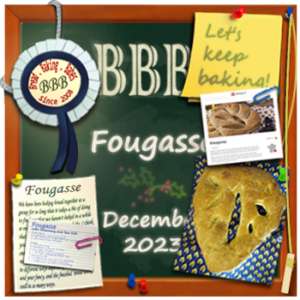
Happy Baking!
Cathy
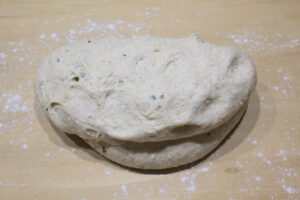
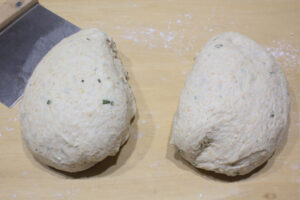
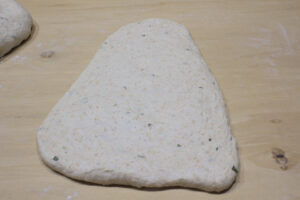
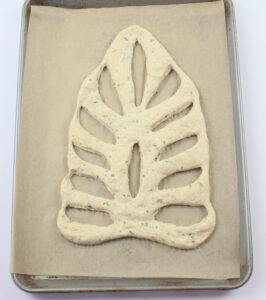
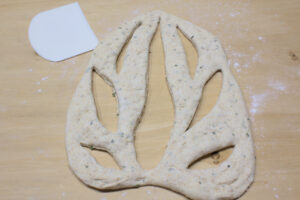
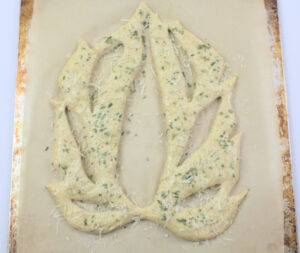
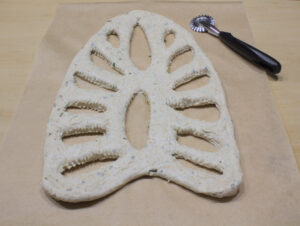
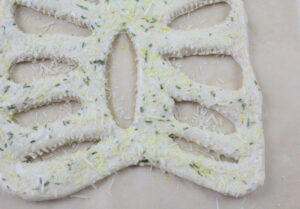
Elle says
I’m going to link this post with mine…hope that is OK…and mention that you have excellent shaping and other advice, plus photos. Love that you kept adding more cheese as you made this again…and that you took a loaf as a gift. It does make a wonderful gift.
I’ve really enjoyed baking with you Cathy. You really get bread right!
Cathy says
Thank you Elle! It’s been a pleasure baking with you as well. Yes, feel free to link to my post. I’m glad it’s helpful!
Karen's Kitchen Stories says
I love your shaping methods! Fresh bread is a great gift, and yours is gorgeous in that windowed bag!
Cathy says
Thanks Karen! I watched some helpful videos to get shaping ideas.
Elizabeth says
All the photos look so good. Especially the photo of the bread you took to the party; it looks wonderful! The hostess must have been so pleased. And the guests must have been even more pleased.
What a great combination: Asiago and rosemary. I can’t stop smiling that you found yourself adding more asiago each time you baked the bread. I also really like your idea of adding rye and spelt to the dough.
(Do you think the commercial yeast is a necessary addition, if your sourdough starter is strong enough?)
Cathy says
Thanks Elizabeth! There were only a few bites left from the bread I brought to the party so I take that to mean they enjoyed it. I definitely enjoyed sharing it. “Needs more cheese” was my mantra each time I made this bread. Big smile.
BTW, I didn’t use any commercial yeast in this bread. I used 27 grams of sourdough starter from the fridge in the overnight levain.
Elizabeth says
That’s a relief to hear. (Oops. I must have misread your recipe. I got confused, reading the BBB sourdough version that did call for the addition of commercial yeast….)
And. There can never be enough cheese. 🙂
Cathy says
I included dried yeast the last couple of BBB bakes, but opted not to for this one. The fougasse worked really well without it.
Katie Zeller says
Asiago cheese…. I can taste it! And they both look beautiful. I can’t believe I’ve never seen that here – or just didn’t pay attention. (shame on me)
Cathy says
Thank you Katie! The Asiago cheese was a delightful addition to the fougasse.
Kelly says
Oh my, that cheese! And the lovely perfection of your leaf veins that stayed wonderfully open too!
Cathy says
Thanks Kelly! I almost made it without the cheese. I’m glad I didn’t. Although I’m looking forward to making fougasse again using different flavor combinations.